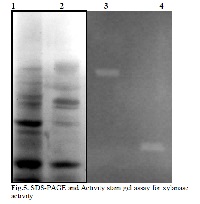Thermophilic xylanase isolated from the Xerophytic- Cereus pterogonus and Opuntia vulgaris plant sp.
Keywords:
Thermophilic, Xerophytic- Cereus pterogonus, Opuntia vulgaris plant sp.Abstract
A thermo stable xylanase was isolated and characterized from the cladodes of crude Cereus pterogonus and Opuntia vulgaris plant species. The enzyme was active in acidic pH 5.0 and temperature optimum for Cereus pterogonus was 60oC and 80oC, where as in the Opuntia vulgaris plant sp showed three temperature isoforms 50oC, 70oC and 90oC respectively. The metal ions 10mM Co2+, Mn2+, 5mM Ni2+ and 1mM Fe3+ showed enzyme activity at 60oC and 80oC for Cereus pterogonus plant sp, where as Opuntia vulgaris plant sp the maximum activity was observed on 50oC, 70oC and 90oC. The crude homogenate of both plant sp showed several protein bands on SDS-PAGE, but two activity bands on the zymogram analysis. The main aim of the present study was to check the xylanase activity on eukaryotic xerophytic plant sp, surprisingly the enzyme activity was observed in Cereus pterogonus and Opuntia vulgaris plant sp. This study may help protein engineers to design more efficient and acidophilic enzymes for use in different biotechnological processes. In future work the enzyme will purify and characterized for various industrial applications.
References
Himmel ME, Ruth MF, Wyman CE.
Cellulase for commodity products from
cellulosic biomass. Curr Opin Biotechnol
; 10: 358-364.
Yang CH, Yang SF, LiuWH. Produciton
of xylooligosaccharfides from xylans by
extracellular xylanases from Thermobida
fusca. J Agri Food Chem 2007; 55: 3955-
Sa-Pereira P, Paveia H, Costa-Ferreira M,
Aires-Barros MR. A new look at
xylanases: An overview of purification
strategies. Mol Biotechnol 2003; 24: 257-
Kulkarni N, Shendye A, Rao M.
Molecular and biotechnological aspects of
xylanases. FEMS Microbiol Rev 1999;
: 411-456.
Choi ID, Kim HY, Choi YJ. Gene cloning
and characterization of α-glucuronidase of
Bacillus Stearothermophilus No. 263.
Biosci Biotechnol Biochem 2000; 64:
-2537.
Ninawe S Kapoor M, Kuhad RC.
Purification and characterization of
extracellular xylanase from Streptomyces
cyaneus SN32. Bioresour Tech 2008; 99:
-1258.
Moure A, Gullo´n p, Domı´nguez H,
Parajo JC. Advances in the manufacture,
purification and applications of xylooligosaccharides as food additives and
utraceuticals. Process Biochem 2006; 41:
-1923.
Whistler R, Richards E. Hemicelluloses.
In: The carbohydrates. (Eds.): W. Pigman
and D. Horton. Vol. IIA, Academic Press,
New York. 1970. p. 447-469.
Zhang GM, Huang J, Huang GR, Ma LX,
Zhang XE. Molecular cloning and
expression of a new xylanase gene from
Plectosphaerella cucmerina. Appl
Microbio Biotechnol 2007; 74: 339-346.
Polezeli MLTM, Rizzatti AC, Monti R,
Terenzi HF, Jorge JA, Smith DS.
Xylanases from fungi: properties and
industrial applications. Minireview Appl.
Microbiol Biotechnol 2005; 67: 577-591.
Szendefy J, Szakacs G, Christopher L.
Potential of solid-state fermentation
enzymes of Aspergillus oryzae in
biobleaching of paper pulp. Enzyme
Microb Tech 2006; 39: 1354-1360.
Miller GL. Use of dinitrosalicylic acid
reagent for determination of reducing
sugar. Anal Chem 1959; 31(3): 426-428.
Bradford MM. A rapid and sensitive
method for the quantitation of microgram
quantities of protein utilizing the principle
of protein dye binding. Anal Biochem
;72(1-2): 248-254.
Laemmli UK. Cleavage of structural
proteins during the assembly of the head
of bacteriophage T4. Nature 1970; 227:
-685.
Blanco A, Pastor FIJ. Characterization of
cellulase-free xylanases from the newly
isolated Bacillus sp. strain BP-23. Can J
Microbiol 1993; 39: 1162-1166.
Heo S, Kwak J. Characterization of an
extracellular xylanase in paenibacillus sp.
HY-8 isolated from an herbivorous
longicorn beetle. J Microbiol and
Biotechnol 2006;16(11): 1753-1759.
Krisana A, Rutchadaporn S. Endo-1,4-β-
xylanase B from Aspergillus cf. niger
BCC14405 isolated in Thailand:
Purification, characterization and gene
isolation. J Biochem and Mol Biol 2005;
: 17-23.
Winterhalter C, Liebl W. Two extremely
thermostable xylanases of the
hyperthermophilic bacterium Thermotoga
maritima MSB8. Appl Environ Microbiol
; 61: 1810-15.
Zverlov V, Piotukh K, Dakhova O,
Velikodvorskaya G, Borriss R. The
multidomain xylanase A of the
hyperthermophilic bacterium Thermotoga
neapolitana is extremely thermoresistant.
Appl Microbiol Biotechnol 1996; 45:
-47.
Dekker RFH, Richards GN. Purification,
properties, and mode of action of
hemicellulase I produced by Ceratocystis
paradoxa. Carbohydr Res 1975; 39: 97-
Mendicuti Castro LP, Trejo-Aguilar BA,
Osorio GA. Thermostable xylanases
produced at 37°C and 45°C by a
thermotolerant Aspergillus strain. FEMS
Microbiol Lett 1997; 146: 97-102.
Janis J, Turunen O, Leisola M, Derrick
PJ, Rouvinen J, Vainiotalo P.
Characterization of mutant xylanases
using fourier transform ion cyclotron
resonance mass spectrometry: Stabilizing
contributions of disulfide bridges and N-
terminal extensions. Biochemistry (Mosc)
; 43: 9556-66.
Nakamura S, Wakabayashi K, Nakai R,
Aono R, Horikoshi K. Purification and
some properties of an alkaline xylanase
from alkaliphilic Bacillus sp. strain 41M-
Appl Environ Microbiol 1993; 59:
-16.
Kim DY, .Han MK, Lee JS, Oh HW,
Park DS, Shin DH, Bae KS,Son H, Park
KHHY. Isolation and characterization of a
cellulase-free endo-β-1,4-xylanase
produced by an invertebrate-symbiotic
bacterium, Cellulosimicrobium sp. HY-
Process Biochem 2009; 44: 1055-59.



